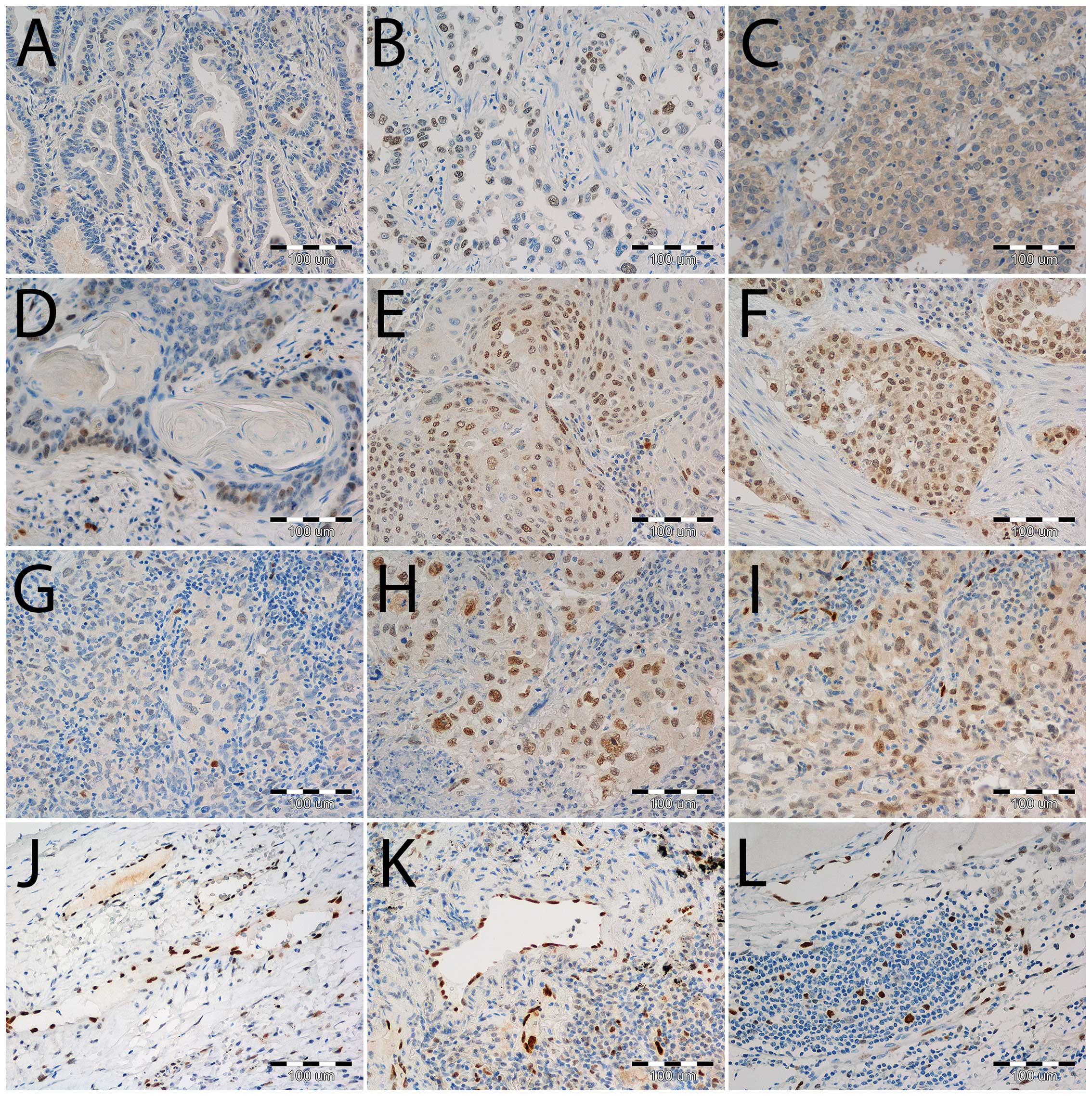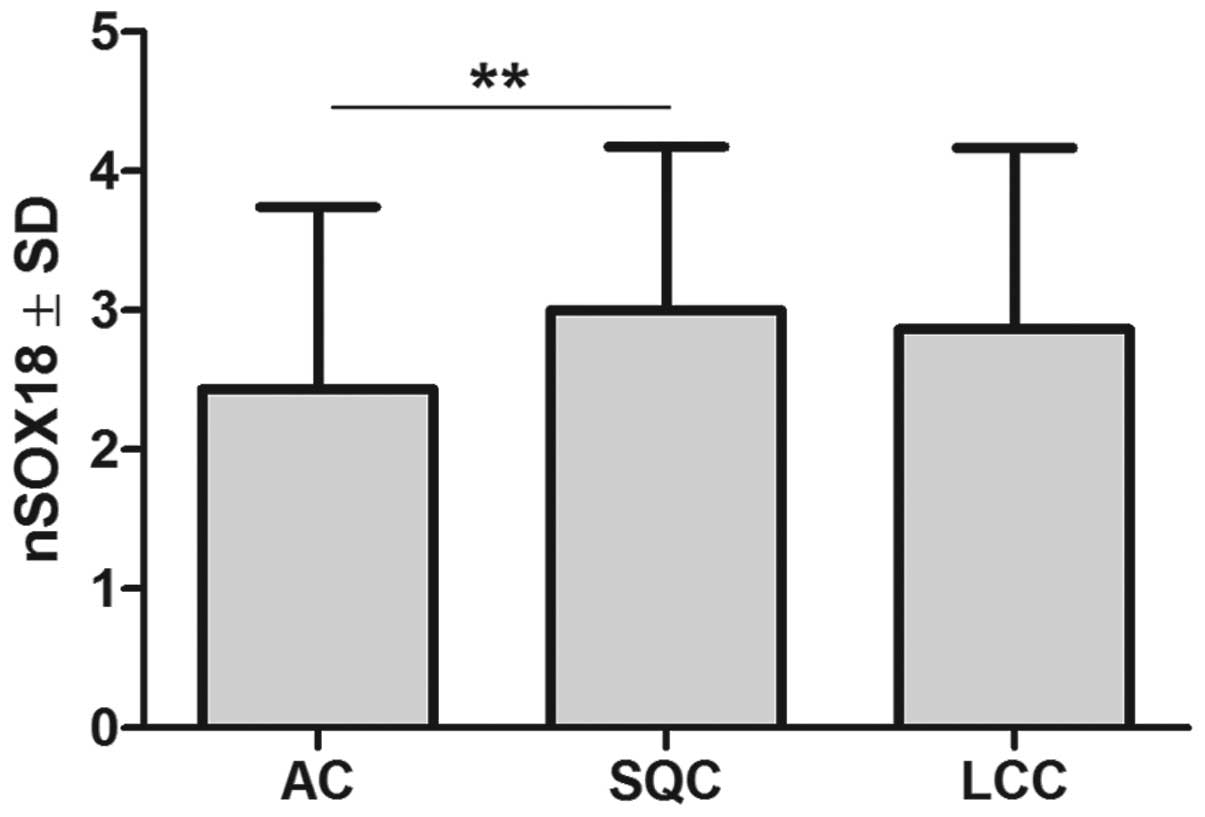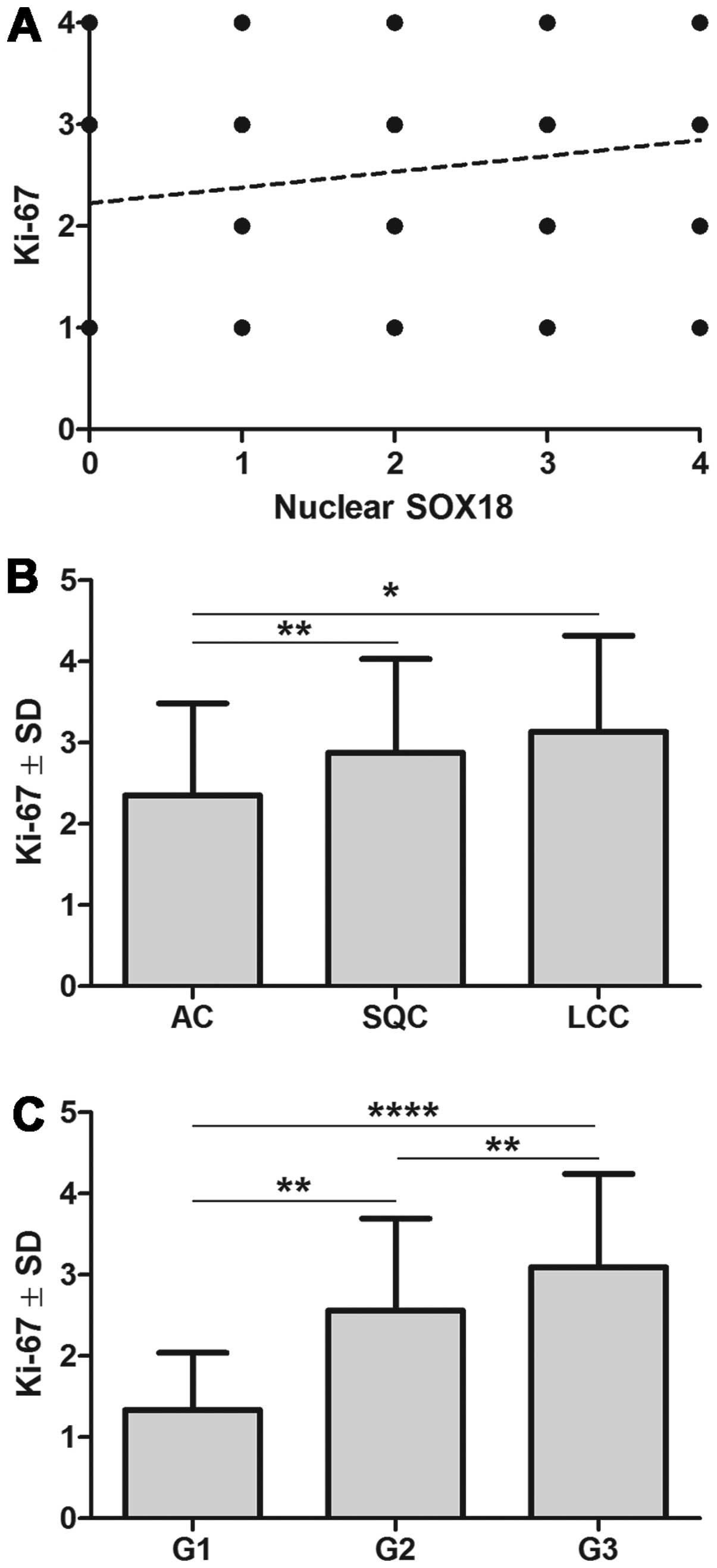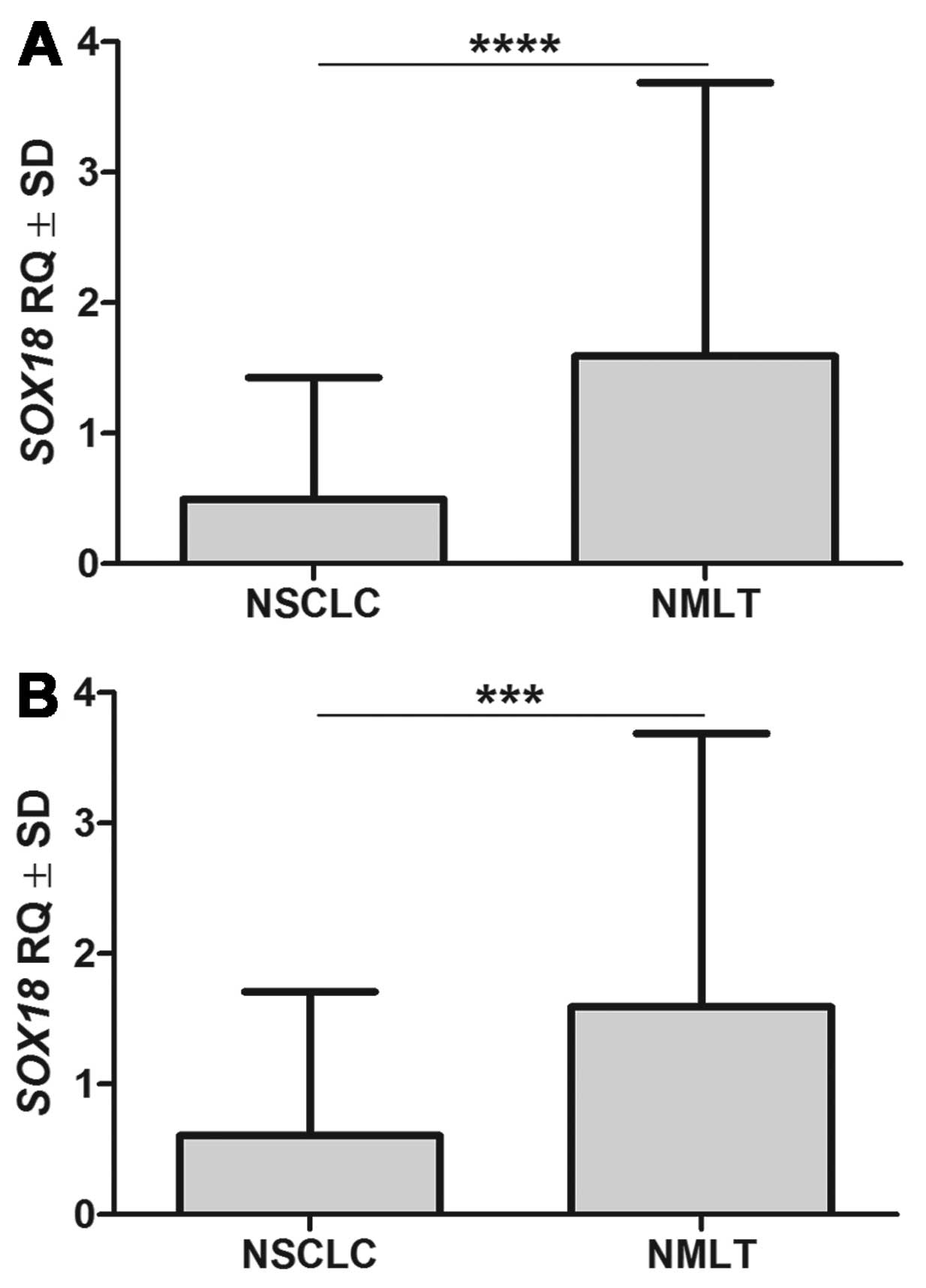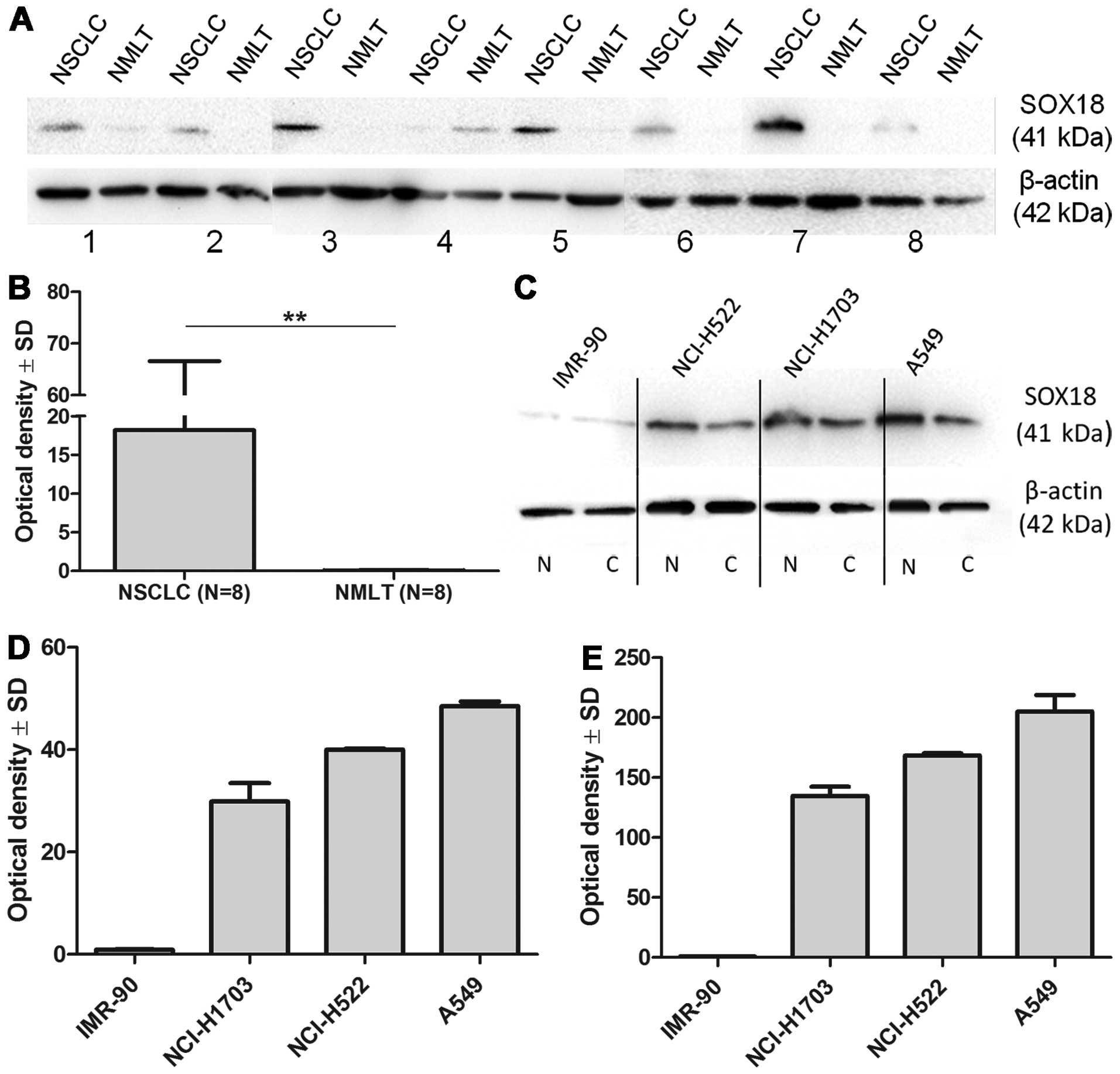Prognostic significance of SOX18 expression in non-small cell lung cancer
- Authors:
- Published online on: October 7, 2014 https://doi.org/10.3892/ijo.2014.2698
- Pages: 123-132
Abstract
Introduction
Lung cancer is the most common malignancy worldwide (accounting for ~12% of cancers) in terms of both incidence and mortality. In addition, a tendency toward increased incidence is estimated (1). More than 80% of diagnosed lung cancers belong to the group of non-small cell carcinomas (NSCLC), and the majority of these cases are diagnosed in advanced disease stages (2). In view of these facts, the discovery of new prognostic and predictive factors is of high importance.
The SOX (sex-determining region on the Y chromosome-related high mobility group box) genes encode a group of transcription factors sharing a high-mobility group (HMG) domain, which specifically binds to the 5′-(A/T)(A/T)CAA (A/T)G-3′ DNA sequence motif (3,4). Through binding with DNA, whether directly or indirectly via co-factors, SOX proteins are capable of regulating transcription. Unlike most transcription factors, the members of the SOX family modify the conformation of DNA by binding to its minor groove (5). Moreover, they are capable of sequestering other transcription factors into complexes (5). The SOX family is divided into ten groups (A–J) based on their amino acid homology (5). SOX18, along with SOX7 and SOX17, is part of the F group (SOX F) of SOX proteins (3,5). Accumulating lines of evidence suggest that SOX18 may influence neonatal, as well as postnatal, vascularization (6–10). Furthermore, SOX7 and SOX17 have been shown to possess some homology, and may complement the function of SOX18 during the above-mentioned procesess (8,11). It has been shown that mutations in SOX18 can lead to defective blood and lymphatic vessel formation, what is observed in the hypotrichosis-lymphedema-telangiectasia syndrome (12–14).
Recent findings indicate that SOX18 may play an important role in tumour growth (15–17). SOX18 expression has been found in cancer cell lines of various malignancies, including breast, gastric and pancreatic cancers (18). Recently, we found that SOX18 expression increases in invasive ductal breast cancer (IDC) cells, and that its expression increases with malignancy grade and amplification of human epidermal growth factor receptor 2 (HER2) (19). In addition, Eom et al (20) found that SOX18, along with SOX7 and SOX17, was overexpressed in gastric cancer tissues, compared to corresponding normal tissues. Analysis of SOX18 immunostained slides showed that SOX18 expression was exclusively noted in the stromal cells (but not in the cancer cells) of the analysed gastric cancers, and its high expression correlated with poor patient survival (20). Evidence suggests that SOX18 expression may also be involved in cell proliferation. Inhibition of SOX18 expression in MCF-7 breast cancer cells and in vascular smooth muscle cells of human atherosclerotic lesions has been observed to lead to decreased proliferation rates in both cell lines (16,21).
To date, SOX18 expression in lung cancer cell lines and tissues has only been studied on the mRNA level. It has been shown that its expression is lower in NSCLC tissues and cancer cell lines; this is associated with increased CpG island hypermethylation of SOX18 promoter (22,23). Moreover, the prognostic significance of SOX18 expression in NSCLC has not yet been determined. In the present study, we therefore, analysed SOX18 expression on the mRNA and on the protein level in a cohort of NSCLC cases, putting emphasis on the clinical and pathological data of the patients in order to determine its prognostic significance.
Materials and methods
Patients and clinical samples
The present study was approved by the Bioethics Commission at the Wroclaw Medical University and investigations were performed after a written informed consent was obtained. The studies were performed on archival material originating from 198 samples of NSCLC taken during surgical resections in 2007–2012 at the Lower Silesia Centre for Pulmonary Diseases in Wroclaw. The study group consisted of 94 adenocarcinomas (AC), 89 squamous cell carcinomas (SQC) and 15 large cell carcinomas (LCC). All the samples used in the present study were collected prior to administration of chemotherapy and radiotherapy. The pTNM classification was made according to the recommendations of the International Association for the Study of Lung Cancer (IASLC) (24). Clinical data were derived from hospital archives and are summarized in Table I. The mean observation time of patients was 27.49±37.19 months (range, 1–147). During this time, 100 (50.5%) of the patients died.
In each case, the paraffin sections were stained with hematoxylin/eosin (H&E) and assessed by two independent pathologists to verify the utility of the samples for immunohistochemical (IHC) studies, the diagnosis, and the degree of tumour malignancy. In case of 42 NSCLC patients, resected tumour fragments and additional non-malignant lung tissue (NMLT) adjacent to the primary tumour of the same 29 patients were collected into RNAlater RNA stabilizing fluid (Qiagen, Hilden, Germany) and stored at −20°C until real-time PCR studies were performed. The group consisted of 23 AC, 16 SQC and 3 LCC cases (Table I). NSCLC and NMLT tissues were also collected and frozen in liquid nitrogen and stored at −80°C in the case of eight patients.
Cell lines
Three NSCLC cell lines (NCI-H1703, NCI-H522 and A549) and a normal lung fibroblast cell line (IMR-90) obtained from the American Type Culture Collection (ATCC, Manassas, VA, USA) were used in the present study. The NCI-H1703 cell line was derived from stage I SQC, the NCI-H522 cell line from stage II AC and the A549 cell line from a highly malignant AC.
Both NCI-H1703 and NCI-H522 cell lines were cultured in RPMI-1640 medium with the addition of 2 mM L-glutamine (Lonza, Basel, Switzerland). The A549 cell line was grown in high glucose DMEM medium and 2 mM L-glutamine, whereas the fibroblastic IMR-90 cell line in the MEM medium was supplemented with non-essential amino acids (Sigma, St. Louis, MO, USA). All media were also supplemented with fetal bovine serum (Sigma), up to a final concentration of 10%. These cell lines were cultured at 37°C and at 5% CO2.
Immunhistochemistry
IHC reactions were performed using a previously established protocol in Autostainer Link 48 (DakoCytomation, Glostrup, Denmark) to ensure repeatable experimental conditions. Murine monoclonal antibodies directed against SOX18 (Santa Cruz Biotechnology, Santa Cruz, CA, USA) and Ki-67 (clone MIB-1; DakoCytomation) were utilized.
The sections were first boiled in Target Retrieval Solution buffer (pH 9.0 for SOX18 and pH 6.0 for Ki-67) using a Pre-Treatment link platform (in order to deparaffinize, rehydrate, and unmask the antigens) and subsequently cooled in a rinsing buffer (TBS/0.1% Tween). The activity of endogenous peroxidase was blocked by 5 min incubation with EnVision FLEX peroxidase-blocking reagent. EnVision FLEX System was used to visualize the antigens. After rinsing the slides in TBS/0.1% Tween buffer, the primary antibodies were applied for 20 min at room temperature. Next, the slides were again rinsed in buffer and incubated for 20 min with secondary antibodies, EnVision FLEX/HRP. To visualize the reaction, sections were incubated for 10 min with EnVision FLEX working solution, where 3,3′-diaminobenzidine (DAB) was used as a chromogen. All slides were counter-stained with EnVision FLEX hematoxylin. Subsequently, the sections were dehydrated in alcohol and xylene, and then mounted in SUB-X mounting medium. All the equipment and reagents besides the SOX18 antibody were obtained in DakoCytomation.
Evaluation of IHC reactions
All IHC sections were evaluated using a BX41 light microscope (Olympus, Tokyo, Japan) by two independent pathologists who were blinded to the patients’ clinical data. SOX18 expression was analysed depending on the cellular localization in the NSCLC cancer cells. Cytoplasmic SOX18 (cSOX18) expression was assessed using the immunoreactive score (IRS) of Remmele and Stegner (25). This scale evaluates the percentage of cells with positive reaction (0 points, absence of cells with positive reaction; 1 point, 1–10% cells with positive reaction; 2 points, 11–50%; 3 points, 51–80%; 4 points, over 80% cells with positive reaction) and the intensity of the reaction (0, no reaction; 1, low intensity of the reaction product; 2, moderate intensity of the reaction colour; and 3, intense colour of the reaction). In the case of nuclear SOX18 (nSOX18) and Ki-67 expression in NSCLC cancer cells, a semi-quantitative scale based on tumour cell positivity in the whole tissue section was employed (26). This scale is encoded as: 0 (0% cells stained), 1 (1–10% cells stained), 2 (11–25% cells stained), 3 (26–50% cells stained) and 4 (51–100% cells stained).
RNA extraction and cDNA synthesis, real-time PCR
The total RNA from the analysed cell lines (NCI-H1703, NCI-H522, A549 and IMR-90), NSCLC, and NMLT tissues was isolated using the RNeasy Mini kit (both Qiagen), according to the manufacturer’s instructions. The protocol included on-column DNAse digestion to eliminate the genomic DNA. RNA quality and integrity were determined by an Agilent 2100 Bioanalyzer on RNA Pico Chips (both Agilent Technologies, Santa Clara, CA, USA). First-strand cDNA was synthesized using the QuantiTect Reverse Transcription kit (Qiagen).
The relative levels of SOX18 mRNA expression were determined by quantitative real-time PCR using the 7900HT Fast Real-Time PCR System and a TaqMan Gene Expression Master Mix (Applied Biosystems, Foster City, CA, USA), according to the manufacturer’s protocols, as in a previous study (19). The primers used were SOX18 Hs00746079_s1 for SOX18 and SDHA Hs00188166_m1 for SDHA (Applied Biosystems), the latter serving as a reference for determining SOX18 expression levels (27). The reactions were carried out in triplicate under the following conditions: initial denaturation at 94°C for 120 sec, followed by 40 cycles of denaturation at 94°C for 15 sec, and annealing and elongation at 60°C for 60 sec. The relative mRNA expression levels of SOX18 were calculated using the ΔΔCt method.
SDS-PAGE and western blot technique
The present study was performed using previously established experimental protocols (19). Whole protein lysates were obtained from the cell lines under study using a Cell Lytic buffer, and from the sampled NSCLC and NMLT tissues using the T-Per tissue protein extraction reagent with the addition of protease inhibitors (both Sigma). In the case of the cell lines, the cytoplasmic and nuclear fractions were obtained using a ProteoExtract subcellular proteome extraction kit according to the manufacturer’s instructions. The samples were then centrifuged again (4°C, 10 min, 10,000 × g) to collect the nuclear extracts. Whole-cell, nuclear and cytoplasmic proteins were quantified using the BCA protein assay (Pierce, Rockford, IL, USA), and resolved on 10% SDS-PAGE gels using the Laemmli method. After electrophoresis, the samples were transferred to polyvinylidene fluoride (PVDF) membranes (Immobilon; Millipore, Bedford, MA, USA) and incubated with anti-human SOX18 antibody (diluted 1:100; Santa Cruz Biotechnology) overnight at 4°C. Next, the membranes were incubated with the secondary anti-mouse antibody conjugated with horseradish peroxidase (Jackson ImmunoResearch, Mill Valley, CA, USA) for 1 h at room temperature, rinsed, and treated with the Immun-Star HRP chemiluminescent kit (Bio-Rad Laboratories, Hercules, CA, USA). β-actin, detected with anti-human β-actin antibody (Abcam, Cambridge, UK), was used as an internal control to normalize the amounts of SOX18 on the same membrane.
Statistical analysis
Prism 5.0 (GraphPad Software, La Jolla, CA, USA) statistical software was used to analyse the results. The non-parametric Mann-Whitney U test (for unpaired observations) and the Wilcoxon signed-rank test (for paired observations) were used to compare groups of data. The associations between clinical and pathological parameters and the expression of the studied IHC markers were analysed using the Fisher’s exact test, and correlations by the Spearman’s correlation test. Survival times were determined by the Kaplan-Meier method, and the significance of the differences was determined by a log-rank test. For each variable, the hazard ratio (HR) and the 95% confidence interval (95% CI) were estimated. In all the analyses, the results were considered statistically significant when P<0.05.
Results
Relationship between immunohistochemical SOX18 expression in NSCLC and patients’ clinical and pathological data
SOX18 expression was noted in cancer cell nuclei, as well as in cytoplasm, in all of the three histological types of NSCLC (Fig. 1). Nuclear SOX18 expression was noted in 187 out of 198 (94.4%) cases, whereas cSOX18 expression was noted in 93 (47%) of the NSCLC cases. SOX18 expression was also observed in nuclei of vessels, and of some of the immune cells in the tumour stroma (Fig. 1). For the purpose of statistical analyses, and based on the median expression levels of nSOX18 and cSOX18, the analysed cases were divided into the following groups: Cases characterized by nSOX18 expression of 0–2 points (≤25% of positive cells) were regarded as ‘low’, whereas those scoring 3–4 points (>25% of positive cells) were regarded as ‘high’. Similarly, cases presenting no cSOX18 expression were classified as negative, whereas those scoring IRS 1–12 were regarded as positive.
A significant positive correlation was observed between nSOX18 and cSOX18 expression in the whole study cohort (r=0.35, P<0.0001), as well as in particular histological types: AC (r=0.30, P=0.0038), SQC (r=0.37, P=0.0003) and LCC (r=0.56, P=0.0306; Spearman correlation test, respectively). Nuclear SOX18 expression was significantly higher in the SQC (3.00±2.87) than in the AC (2.44±2.87) cases (P=0.0021, Mann-Whitney U test; Fig. 2), however, no significant differences were noted in regard to cSOX18 immunoreactivity between particular NSCLC histological types (AC, IRS 1.00±1.29; SQC, IRS 1.21±1.50; and LCC, IRS 1.47±1.60). Moreover, nSOX18 expression correlated positively with the expression of the Ki-67 antigen (r=0.17, P=0.0139, Spearman correlation test; Fig. 3A). It is noteworthy that Ki-67 antigen expression differed among the particular NSCLC histological types. Significantly lower Ki-67 antigen expression was noted in the AC cases (2.25±1.13), as compared with the SQC (2.88±1.16, P=0.002) and LCC (3.13±1.87) cases (both Mann-Whitney U test; Fig. 3B). Ki-67 antigen expression increased with growing malignancy grade of the tumours (G1, 1.33±0.70; G2, 2.56±1.34; and G3, 3.09±1.15). Significant differences were noted using the Mann-Whitney U test between G1 tumours and those of G2 and G3 (P=0.0024 and P<0.0001, respectively). Also significant differences were observed between G2 and G3 cancers (P=0.024, Mann-Whitney U test; Fig. 3C).
Analysis of nuclear and cytoplasmic SOX18 immunoreactivity in the whole cohort, as well as in the AC and SQC types, revealed that higher nSOX18 expression was associated with male gender of SQC patients (P=0.0281, Fisher’s exact test; Table II). However, no other association of nSOX18 and cSOX18 expression levels with the age of the patients, gender, primary tumour size, presence of lymph node metastasis or disease stage were noted (Tables II and III).
Table IIAssociation of nuclear SOX18 (nSOX18) expression with the clinical and pathological data of patients. |
Table IIIAssociation of cytoplasmic SOX18 (cSOX18) expression with clinical and pathological data of the studied patients. |
SOX18 mRNA and protein expression in NMLT and NSCLC with regard to patients’ clinical and pathological characteristics
Real-time PCR analysis of SOX18 mRNA expression was achieved in 39 out of 42 (92.9%) analysed NSCLC samples and in all of the 29 NMLT cases. Significantly higher SOX18 mRNA expression level was observed in NMLT (RQ 1.59±2.09) tissues than in NSCLC, both for all the analysed samples (RQ 0.49±0.93, P<0.0001, Mann-Whitney U test) and for the paired cases (RQ 0.60±1.10, P=0.0004, Wilcoxon signed-rank test; Fig. 4). In the paired sample analysis, a higher SOX18 mRNA expression was noted in 27 (93.1%) cases of NMLT, as compared with NSCLC. Statistical analysis did not reveal any significant associations between the level of SOX18 mRNA expression level and patients’ clinical and pathological data (Table IV).
Table IVSOX18 mRNA expression, and clinical and pathological data of non-small cell lung cancer patients. |
SOX18 expression determined in the paired frozen samples of NMLT and NSCLC using the western blot technique revealed significantly higher expression in the latter (18.18±48.44 vs. 0.05±0.06, P=0.018, Wilcoxon signed-rank test; Fig. 5A and B).
SOX18 expression in lung cancer cell lines and normal lung fibroblasts
Analysis of SOX18 protein levels using the western blot technique in the studied cell lines revealed increased expression in the cytoplasmic/membranous fraction, as well as in the nuclear fraction, of NCI-H1703, NCI-H522 and A549 cancer cell lines (Fig. 5C–E). However, no SOX18 expression could be noted in the corresponding cellular fractions of the normal lung fibroblast cell line (IMR-90).
Prognostic significance of SOX18 expression in NSCLC
Univariate analysis of patient survival in the whole study group revealed that the presence of cytoplasmic SOX18 expression was associated with poor patient outcome (P=0.0077; Table V). From among the factors considered in this group, AC histological type (P=0.0076), larger primary tumour size (P=0.0056), presence of lymph node metastases (P=0.0001), advanced disease stage (P=0.0004) and patient age (P=0.0085) were also associated with poor prognosis. Cytoplasmic SOX18 expression was a negative prognostic factor also in the group of 94 AC (P=0.0048), as were larger primary tumour size (P=0.0197), the presence of lymph node metastases (P=0.0064), advanced disease stage (P=0.0291) and age (P=0.321) (Table V). Univariate survival analysis in the SQC group showed that G3 malignancy grade (P=0.0436) and the presence of lymph node metastases (P=0.0006) were associated with poor patient survival (Table V).
Table VUnivariate survival analysis of the whole study cohort and in the adenocarcinoma and squamous cell lung cancer patients. |
Discussion
Accumulating lines of evidence point to the potential role of SOX18 transcription factor in the progression of various cancers. Recently, we showed that high nuclear immunoreactivity in cancer cells of IDC is associated with higher malignancy grade and HER2 amplification (19). SOX18 expression has also been detected in cell lines derived from melanoma, as well as from gastric, pancreatic and breast cancer (16,18,19). Moreover, increased SOX18 expression in gastric cancer stroma (though not in cancer cells) was associated with poor outcome of the patients (20). SOX18 expression has also been studied in NSCLC tissues and its derived cancer cell lines, but only on the mRNA level (and without addressing its prognostic value) (22,23).
To the best of our knowledge, we are the first to assess SOX18 expression on the protein level (using both IHC and the western blot technique) in NMLT, NSCLC specimens and cancer cell lines. We observed SOX18 immunoreactivity in the nuclei and cytoplasm of cancer cells in paraffin sections, as well as in the lung cancer cell lines that we investigated (NCI-H1703, NCI-H522 and A549). The results of the present study are in line with our previous observations regarding SOX18 expression in IDC tissues and its cell lines (19). Moreover, in the current study, as well as in that of Pula et al (19), we detected no SOX18 expression in fibroblasts of immunostained paraffin sections of NSCLC and IDC. In addition, no expression of this transcription factor was noted in the fibroblastic cell lines IMR-90 and NHDF which corresponds well with the results derived from the IHC sections. The cytoplasmic expression of SOX18 in lung cancer cells may be partly explained by the structure of this transcription factor. The HMG domain of this transcription factor has been shown to be capable of binding other compounds, thus mediating protein-protein interactions (28,29). It may be possible that SOX18 has additional unrecognized functions in cytoplasm, such as regulating the activity of the Wnt signalling pathway, as has been demonstrated for the other members of the SOX F family, SOX7 and SOX17 (30,31).
We observed a discrepancy between the mRNA and protein expression of SOX18 in NMLT and NSCLC tissues. We noted significantly lower mRNA expression levels of this transcription factor in the paired tissues and in all of the studied NSCLC tissues, as compared to NMLT. This finding is in accordance with the previous observations of Azhikina et al (23) and Dammann et al (22), who identified higher methylation levels of SOX18 promoter in NSCLC tissues and lung cancer cell lines. In contrast to SOX18 mRNA levels, its protein expression increased in NSCLC tissues, as determined utilizing the western blot technique. Due to these discrepancies, our findings may point to the existence of a negative regulative feedback loop in SOX18 expression. Based on the previous observations of Azhikina et al (23) and Dammann et al (22), it is possible that the decreased SOX18 mRNA expression in NSCLC tissues is caused by promoter hypermethylation, which is frequently observed in this malignancy (32). Transcription factors of the SOX F group have been shown to complement their functions during angiogenesis and lymphangiogenesis (8,10,11). In line with the above mentioned capability, SOX7 and SOX17 mRNA expression have also been shown to be significantly downregulated in NSCLC as compared to NMLT (31,33,34).
In this study, we observed a positive correlation between nuclear SOX18 immunoreactivity and that of the Ki-67 antigen in cancer cells of NSCLC. These observations may point to a possible role of SOX18 in the regulation of the proliferation rate of cancer cells. Previous studies have shown that SOX18 expression influences the proliferation of MCF-7 and VSMC cell lines (16,21). Inhibition of this protein leads to a decrease in the proliferation of both cell lines. Moreover, the impact of SOX18 on cellular proliferation may be indirectly supported by the results of Darby et al (15), who showed that SOX18 mRNA expression increased during wound healing and diminished after the process ended.
In the present study, we have demonstrated that cytoplasmic SOX18 expression is associated with poor patient outcome for both the study cohort as a whole and for the AC subtype only. Interestingly, the intensity of immunoreactivity of SOX18 nuclei did not influence patient survival, although a positive correlation with the expression of Ki-67 antigen was recorded. The latter also increased with the malignancy grade of the tumours, but did not impact patients’ overall survival. The observed poor outcome of NSCLC and AC patients characterized by increased cytoplasmic SOX18 expression may result from its possible regulation of the Wnt signalling pathway (30). Nevertheless, further studies are needed to fully clarify this mechanism.
In summary, we have shown for the first time that SOX18 is expressed in cancer cells and vessels of NSCLC. Moreover, its expression is differentiated in regard to cellular localization. Based on our observations, cytoplasmic expression of SOX18 may be a new prognostic marker of poor prognosis in NSCLC. However, further studies are needed to warrant its prognostic utility in this malignancy.
Acknowledgements
The present study was supported by a research grant from the Wrovasc Integrated Cardiovascular Centre Project, and co-financed by the European Regional Development Fund within the Innovative Economy Operational Program, 2007–2013 realized in Regional Specialist Hospital, Research and Development Centre in Wroclaw.
References
|
Siegel R, Naishadham D and Jemal A: Cancer statistics, 2013. CA Cancer J Clin. 63:11–30. 2013. View Article : Google Scholar | |
|
Brandao GD, Brega EF and Spatz A: The role of molecular pathology in non-small-cell lung carcinoma-now and in the future. Curr Oncol. 19(Suppl 1): S24–S32. 2012. View Article : Google Scholar : PubMed/NCBI | |
|
Wegner M: From head to toes: the multiple facets of Sox proteins. Nucleic Acids Res. 27:1409–1420. 1999. View Article : Google Scholar : PubMed/NCBI | |
|
Harley VR, Lovell-Badge R and Goodfellow PN: Definition of a consensus DNA binding site for SRY. Nucleic Acids Res. 22:1500–1501. 1994. View Article : Google Scholar : PubMed/NCBI | |
|
Wegner M: All-purpose Sox: the many roles of Sox proteins in gene expression. Int J Biochem Cell Biol. 42:381–390. 2010. View Article : Google Scholar : PubMed/NCBI | |
|
Francois M, Koopman P and Beltrame M: SoxF genes: key players in the development of the cardio-vascular system. Int J Biochem Cell Biol. 42:445–448. 2010. View Article : Google Scholar : PubMed/NCBI | |
|
Cermenati S, Moleri S, Cimbro S, et al: Sox18 and Sox7 play redundant roles in vascular development. Blood. 111:2657–2666. 2008. View Article : Google Scholar : PubMed/NCBI | |
|
Hosking B, Francois M, Wilhelm D, et al: Sox7 and Sox17 are strain-specific modifiers of the lymphangiogenic defects caused by Sox18 dysfunction in mice. Development. 136:2385–2391. 2009. View Article : Google Scholar : PubMed/NCBI | |
|
Matsui T, Kanai-Azuma M, Hara K, et al: Redundant roles of Sox17 and Sox18 in postnatal angiogenesis in mice. J Cell Sci. 119:3513–3526. 2006. View Article : Google Scholar : PubMed/NCBI | |
|
Sakamoto Y, Hara K, Kanai-Azuma M, et al: Redundant roles of Sox17 and Sox18 in early cardiovascular development of mouse embryos. Biochem Biophys Res Commun. 360:539–544. 2007. View Article : Google Scholar : PubMed/NCBI | |
|
Herpers R, van de Kamp E, Duckers HJ and Schulte-Merker S: Redundant roles for sox7 and sox18 in arteriovenous specification in zebrafish. Circ Res. 102:12–15. 2008. View Article : Google Scholar : PubMed/NCBI | |
|
Downes M, Francois M, Ferguson C, et al: Vascular defects in a mouse model of hypotrichosis-lymphedema-telangiectasia syndrome indicate a role for SOX18 in blood vessel maturation. Hum Mol Genet. 18:2839–2850. 2009. View Article : Google Scholar | |
|
Francois M, Caprini A, Hosking B, et al: Sox18 induces development of the lymphatic vasculature in mice. Nature. 456:643–647. 2008. View Article : Google Scholar : PubMed/NCBI | |
|
Irrthum A, Devriendt K, Chitayat D, et al: Mutations in the transcription factor gene SOX18 underlie recessive and dominant forms of hypotrichosis-lymphedema-telangiectasia. Am J Hum Genet. 72:1470–1478. 2003. View Article : Google Scholar : PubMed/NCBI | |
|
Darby IA, Bisucci T, Raghoenath S, et al: Sox18 is transiently expressed during angiogenesis in granulation tissue of skin wounds with an identical expression pattern to Flk-1 mRNA. Lab Invest. 81:937–943. 2001. View Article : Google Scholar : PubMed/NCBI | |
|
Young N, Hahn CN, Poh A, et al: Effect of disrupted SOX18 transcription factor function on tumor growth, vascularization, and endothelial development. J Natl Cancer Inst. 98:1060–1067. 2006. View Article : Google Scholar : PubMed/NCBI | |
|
Duong T, Proulx ST, Luciani P, et al: Genetic ablation of SOX18 function suppresses tumor lymphangiogenesis and metastasis of melanoma in mice. Cancer Res. 72:3105–3114. 2012. View Article : Google Scholar : PubMed/NCBI | |
|
Saitoh T and Katoh M: Expression of human SOX18 in normal tissues and tumors. Int J Mol Med. 10:339–344. 2002.PubMed/NCBI | |
|
Pula B, Olbromski M, Wojnar A, et al: Impact of SOX18 expression in cancer cells and vessels on the outcome of invasive ductal breast carcinoma. Cell Oncol (Dordr). 36:469–483. 2013. View Article : Google Scholar : PubMed/NCBI | |
|
Eom BW, Jo MJ, Kook MC, et al: The lymphangiogenic factor SOX 18: a key indicator to stage gastric tumor progression. Int J Cancer. 131:41–48. 2012. View Article : Google Scholar : PubMed/NCBI | |
|
Garcia-Ramirez M, Martinez-Gonzalez J, Juan-Babot JO, et al: Transcription factor SOX18 is expressed in human coronary atherosclerotic lesions and regulates DNA synthesis and vascular cell growth. Arterioscler Thromb Vasc Biol. 25:2398–2403. 2005. View Article : Google Scholar : PubMed/NCBI | |
|
Dammann R, Strunnikova M, Schagdarsurengin U, et al: CpG island methylation and expression of tumour-associated genes in lung carcinoma. Eur J Cancer. 41:1223–1236. 2005. View Article : Google Scholar : PubMed/NCBI | |
|
Azhikina T, Kozlova A, Skvortsov T and Sverdlov E: Heterogeneity and degree of TIMP4, GATA4, SOX18, and EGFL7 gene promoter methylation in non-small cell lung cancer and surrounding tissues. Cancer Genet. 204:492–500. 2011. View Article : Google Scholar : PubMed/NCBI | |
|
Detterbeck FC, Boffa DJ and Tanoue LT: The new lung cancer staging system. Chest. 136:260–271. 2009. View Article : Google Scholar | |
|
Remmele W and Stegner HE: Recommendation for uniform definition of an immunoreactive score (IRS) for immunohisto-chemical estrogen receptor detection (ER-ICA) in breast cancer tissue. Pathologe. 8:138–140. 1987.(In German). | |
|
Werynska B, Pula B, Muszczynska-Bernhard B, et al: Metallothionein 1F and 2A overexpression predicts poor outcome of non-small cell lung cancer patients. Exp Mol Pathol. 94:301–308. 2013. View Article : Google Scholar : PubMed/NCBI | |
|
Doroudi R, Andersson M, Svensson PA, et al: Methodological studies of multiple reference genes as endogenous controls in vascular gene expression studies. Endothelium. 12:215–223. 2005. View Article : Google Scholar : PubMed/NCBI | |
|
Lefebvre V, Dumitriu B, Penzo-Mendez A, et al: Control of cell fate and differentiation by Sry-related high-mobility-group box (Sox) transcription factors. Int J Biochem Cell Biol. 39:2195–2214. 2007. View Article : Google Scholar : PubMed/NCBI | |
|
Wilson M and Koopman P: Matching SOX: partner proteins and co-factors of the SOX family of transcriptional regulators. Curr Opin Genet Dev. 12:441–446. 2002. View Article : Google Scholar : PubMed/NCBI | |
|
Zhu Y, Li Y, Jun Wei JW and Liu X: The role of sox genes in lung morphogenesis and cancer. Int J Mol Sci. 13:15767–15783. 2012. View Article : Google Scholar : PubMed/NCBI | |
|
Yin D, Jia Y, Yu Y, et al: SOX17 methylation inhibits its antagonism of Wnt signaling pathway in lung cancer. Discov Med. 14:33–40. 2012.PubMed/NCBI | |
|
Tessema M, Willink R, Do K, et al: Promoter methylation of genes in and around the candidate lung cancer susceptibility locus 6q23-25. Cancer Res. 68:1707–1714. 2008. View Article : Google Scholar | |
|
Hayano T, Garg M, Yin D, et al: SOX7 is down-regulated in lung cancer. J Exp Clin Cancer Res. 32:172013. View Article : Google Scholar : PubMed/NCBI | |
|
Li B, Ge Z, Song S, et al: Decreased expression of SOX7 is correlated with poor prognosis in lung adenocarcinoma patients. Pathol Oncol Res. 18:1039–1045. 2012. View Article : Google Scholar : PubMed/NCBI |



